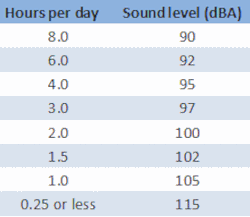Health Hazards
This module will continue the discussion about the various health hazards to which hazardous waste site and construction workers are exposed.
These topics will help you better understand and react to occupational health hazards in construction. The topics we will discuss in this module include:
- excessive noise
- ionizing and non-ionizing radiation
- exposure to asbestos
Excessive Noise
Every year, approximately 30 million people in the United States are occupationally exposed to hazardous noise. Employers must have a hearing conservation program whenever employee noise exposures equal or exceed an eight-hour time-weighted average sound level (TWA) of 85 A-weighted decibels (dBA). A decibel is an expression of the relative loudness of sound in air as perceived by the human ear.
When employees are exposed to sound levels exceeding those listed in the table to the right, administrative or engineering controls must be used. For instance, if employees are exposed to an average of 90 dBA over an 8-hour workday, then hearing protection controls must be used.
To reduce exposure to excessive noise at a worksite, take the following precautions:
- Reduce the time workers spend in noisy areas.
- Rotate two or more workers so that each is exposed to noise less than 85 dBA, averaged over an eight-hour day.
- Shut down noisy equipment when it is not needed.
- Maintain equipment so it runs smoothly and quietly.
- Ensure workers know how to perform their tasks and operate equipment at safe noise levels.
- Use earplugs and earmuffs. To be effective, they must totally block the ear canal with an airtight seal. An improperly fitted, dirty, or worn-out plug will not seal and can irritate the ear canal.
Knowledge Check Choose the best answer for the question.
5-1. What is a method of reducing exposure to excessive noise at a worksite?
You forgot to answer the question!


